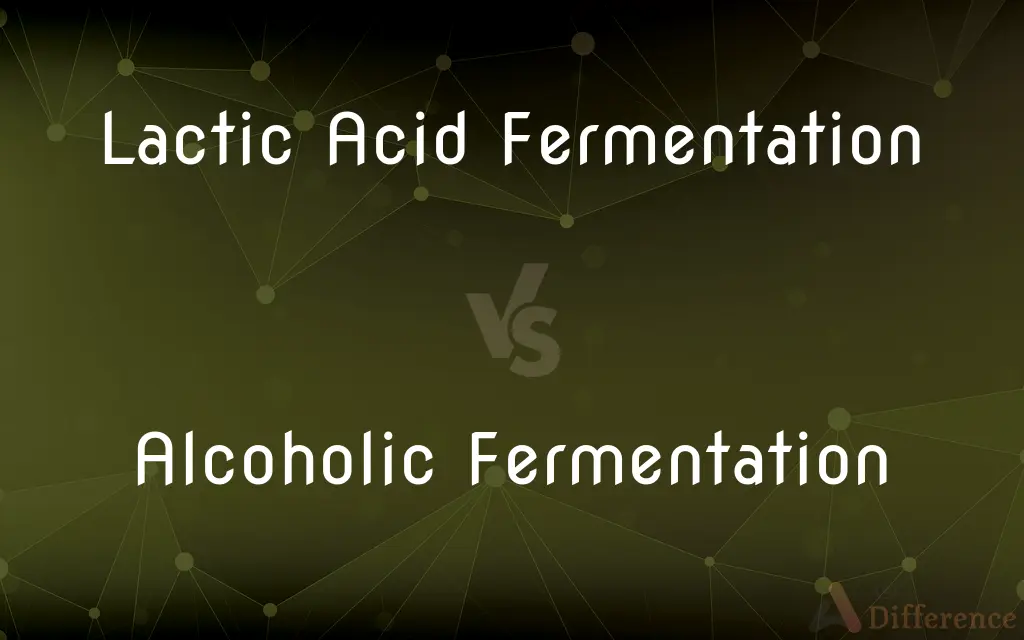Lactic Acid Fermentation vs. Alcoholic Fermentation — What's the Difference?
By Tayyaba Rehman — Published on December 15, 2023
Lactic Acid Fermentation produces lactic acid from glucose, often in muscles, while Alcoholic Fermentation yields ethanol and carbon dioxide, commonly in yeast.

Difference Between Lactic Acid Fermentation and Alcoholic Fermentation
Table of Contents
ADVERTISEMENT
Key Differences
Lactic Acid Fermentation is a metabolic process where sugar is converted into lactic acid, usually in the absence of oxygen. On the other hand, Alcoholic Fermentation is the conversion of sugars into ethanol (alcohol) and carbon dioxide, predominantly through yeast activity.
Lactic Acid Fermentation frequently occurs in muscle cells of organisms when they're deprived of oxygen, leading to the soreness felt after intense physical activity. In contrast, Alcoholic Fermentation is the principal process in brewing and winemaking, where yeasts transform sugars from grains or fruits into alcohol.
Lactic Acid Fermentation is essential in producing foods like yogurt, sauerkraut, and certain pickled vegetables. Alcoholic Fermentation, however, is key for alcoholic beverages such as beer, wine, and spirits, and also for the leavening in bread.
While Lactic Acid Fermentation results in the production of lactic acid, Alcoholic Fermentation produces not only alcohol but also carbon dioxide, which causes the characteristic bubbles in many alcoholic drinks and the rise in bread.
Both Lactic Acid Fermentation and Alcoholic Fermentation are anaerobic processes. They provide a means for cells to produce energy in the absence of oxygen, albeit less efficiently than aerobic respiration.
ADVERTISEMENT
Comparison Chart
Primary Product
Lactic acid.
Ethanol and carbon dioxide.
Common Occurrence
Muscle cells during intense activity.
Yeast during brewing and winemaking.
Application in Food
Yogurt, sauerkraut, pickled vegetables.
Beer, wine, spirits, bread leavening.
Energy Production
Anaerobic respiration.
Anaerobic respiration.
Associated Sensation in Humans
Muscle soreness due to lactic acid buildup.
Intoxication from alcohol and bread rise due to CO₂.
Compare with Definitions
Lactic Acid Fermentation
Bacterial fermentation yielding lactic acid.
Sauerkraut is made through Lactic Acid Fermentation of cabbage.
Alcoholic Fermentation
Primary metabolic route in winemaking.
Alcoholic Fermentation turns grape sugars into wine.
Lactic Acid Fermentation
Anaerobic conversion of glucose into lactic acid.
During strenuous exercise, Lactic Acid Fermentation can cause muscle soreness.
Alcoholic Fermentation
Yeast-driven process producing alcohol and gas.
Bubbles in champagne result from Alcoholic Fermentation's CO₂.
Lactic Acid Fermentation
Cellular energy source in oxygen-deprived conditions.
When cells lack oxygen, they may undergo Lactic Acid Fermentation.
Alcoholic Fermentation
Creation of ethanol from carbohydrates.
Distilled spirits originate from Alcoholic Fermentation.
Lactic Acid Fermentation
Metabolic route creating energy and lactic acid.
Muscles resort to Lactic Acid Fermentation when oxygen is scarce.
Alcoholic Fermentation
Anaerobic conversion of sugars to ethanol and CO₂.
Beer production relies on Alcoholic Fermentation by yeast.
Lactic Acid Fermentation
Process producing lactic acid without oxygen.
Yogurt results from Lactic Acid Fermentation of milk sugars.
Alcoholic Fermentation
Energy-producing fermentation yielding alcohol.
In the absence of oxygen, some yeasts resort to Alcoholic Fermentation.
Common Curiosities
What is Lactic Acid Fermentation?
It's the conversion of sugars to lactic acid without oxygen.
Where does Lactic Acid Fermentation commonly occur?
Often in muscle cells during oxygen-deficient conditions.
Is Lactic Acid Fermentation responsible for muscle soreness?
Yes, it can cause a buildup of lactic acid in muscles.
What organisms primarily do Alcoholic Fermentation?
Yeasts are the main agents.
How does Alcoholic Fermentation differ?
It turns sugars into ethanol and carbon dioxide, mainly in yeast.
What are typical products of Alcoholic Fermentation?
Alcoholic beverages like beer and wine, and leavened bread.
How is Alcoholic Fermentation crucial in baking?
It produces CO₂, making bread rise.
Why is Lactic Acid Fermentation essential in food preservation?
It can inhibit the growth of harmful bacteria.
Can humans perform Lactic Acid Fermentation?
Yes, especially in muscles during intense activity.
Share Your Discovery

Previous Comparison
HB Pencil vs. No. 2 Pencil
Next Comparison
Members vs. ShareholdersAuthor Spotlight
Written by
Tayyaba RehmanTayyaba Rehman is a distinguished writer, currently serving as a primary contributor to askdifference.com. As a researcher in semantics and etymology, Tayyaba's passion for the complexity of languages and their distinctions has found a perfect home on the platform. Tayyaba delves into the intricacies of language, distinguishing between commonly confused words and phrases, thereby providing clarity for readers worldwide.












































